RDS (ROSEMARY DEATH SYNDROME) SOLVED?
Lack of Water Could Be the Cause
Looks like I’ve done it again. Killed rosemary, the plant. Worse than that, I’ve killed two rosemary plants. And even worse still, drawing on my experiences killing numerous rosemary plants — perhaps you also have killed one or more — I’ve been dispensing my “expertise” on how not to kill rosemary.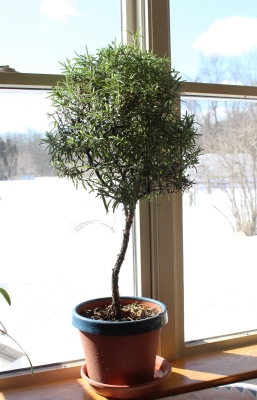
My reasoning went like this: Although native to the generally dry climate of the Mediterranean region, roots of rosemary plants in the ground there can reach far and wide in their explorations for water. Not so for rosemary plants that need to live in pots here, where winters are too cold for them outdoors.
To make matters worse, rosemary’s stiff, needle-like leaves don’t signal that the plant is crying out from thirst by wilting. The leaves just sit there on the stems looking perky until, if the soil has been too dry for too long, the leaves still hold their place and shape but take on a bluish cast. At this point the stems will rain down dry leaves if accidentally or purposely brushed against.
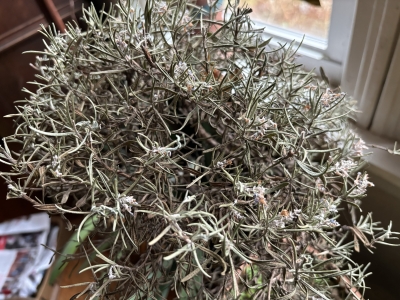
Rosemary, dead
Dry needles don’t necessarily signal that a plant is dead. But it might be. I’ve revived near-dead plants with timely watering. In fact, one of the two recent deaths was a revival.
But . . .
Giving more thought to RDS (Rosemary Death Syndrome) may absolve me of some of the blame. Sure, desiccation will kill rosemary, just as it will kill any plant. Rosemary just doesn’t cry for help along the way.
I grow rosemary as “standards.” Quoting from this chapter of my pruning book (The Pruning Book), “Standard” has many meanings . . . [it’s] a naturally bushy, small plant trained to have a clear, upright stem capped by a mop of leaves. A miniature tree. I count myself among standardophiles and, if I may speak for the group, we like standards for their neatness and because they have the lollipop shape of storybook trees. “Standard” does seem like an odd word to describe such a plant until you realize that . . . “standard” . . . [comes] from the Old English words standan, meaning to stand, and ord, meaning a place.
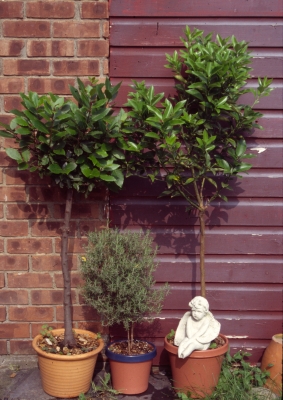
Standard bay, rosemary, kumquat
Naturally bushy plants are bushy because they send up new sprouts from ground level and/or sprawl over the ground often rooting wherever a stem touches the ground. But bushy plants don’t have long-lived stems. If they did, those stems would become trunks. And that’s the “formal wear” into which I’ve always forced my rosemaries.
I’ve had similar experiences with other plants. Years ago I trained a red currant bush into an attractive espalier. The plant protested as I kept pruning back any sprouts trying to grow up from or near ground level. I got the upper hand and eventually had a single trunk capped, at a height of about three feet, by two permanent arms running in opposite directions along the top of my garden fence. It was a sight to behold each July when the translucent berries dangled down like jewels along the arms. The “trunk” eventually got old and the plant died.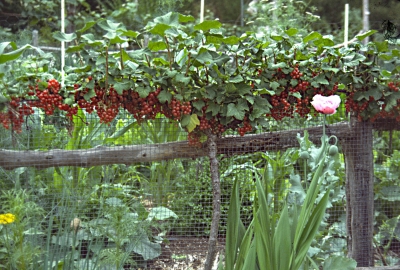
I similarly trained some clove currants, these plants for their very fragrant trumpets of yellow flowers. Clove currant, which sends runners and stems arching to the ground all over the place, is even less inclined to be tree-like than red currant. The three little “trees” were beautiful while they lasted.
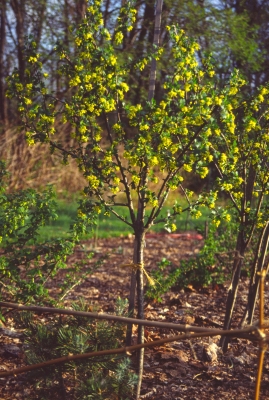
Clove currant “tree”
The point is that bushy plants don’t have long-lived trunks, and these plants vary in just how long their stems can remain vigorous. My two rosemary standards evidently came to the end of their line.
New Plants on the Way
Fortunately, lots of people don’t grow potted rosemaries as standards. I was able to get some stems from a friend with which to make new plants.
Also fortunately, rosemary is relatively easy to root. I took some semi-woody shoots and stripped off most of the lower leaves, then plunged the bases into a mix of equal parts peat moss and perlite. Warm roots and cool air would be ideal, as would be some rooting powder, but all that’s not a necessity. I have a heating mat to provide, at least, bottom warmth to foster root formation.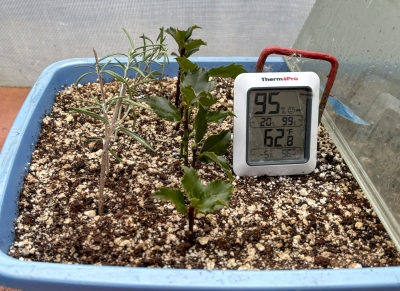
The cuttings do need some kind of covering to maintain high humidity until roots form. Clear plastic, either a bag or inverted tub, does the trick. The setup needs to be in bright light so leaves can photosynthesize to feed growing roots, but out of direct sunlight or else they’ll cook.
Soon I’ll have new rosemary plants on their way to standard-dom.
One other thought: Perhaps I overcompensated with watering my two rosemary plants. Too much water can also kill a rosemary plant, most cultivated plants in fact.



So what is your recommendation for espaliering red currants? I am about to start the third year of growing a currant espaliered according to Grow Fruit Naturally. In fact I am awaiting delivery of more currants to add to the trellis on either side of the existing plant. Should I not espalier the new plants and stop cutting back the older one or continue with one but not train the new plants rigorously. The entirety of my knowledge about pruning currants comes from your books, all of which I turn to often. Thank you.
Please see my response to your next comment.
I tolerate a few miners lettuce plants in the pots of my kumquat and limequat. When the miners lettuce wilts I can see that I need to water… My rosemary is in the ground (zone 7) and has lived through many winters. This year it looks like it got quite a bit of winter damage, I’m guessing from sunny freezing days but could also be from the huge amount of winter rain.
Outdoors in one 7 is a different ballgame than indoors. I like the miner’s lettuce idea.
Hi Lee –
I too have been guilty of a rosemary murder! My replacement plant, I can proudly say, is now on it’s 2nd winter. My struggles have been with the development of powdery mildew each year when it is indoors. I have been battling and (mostly) winning using a spray mixture of lemon juice and water. I do love standards though, and have a couple very homely coleus standards I started and am trying to coax some beauty out of it lol. Your red current espalier was gorgeous! Happy gardening!
I’ve heard about powdery mildew on indoor rosemary plants but have never seen it on mine. Are you sure it’s powdery mildew. Rosemary naturally has a really coating on its leaves.
What is your recommendation about espaliering red currants? I have been espaliering a red currant per Growing Fruit Naturally. This season will be the third year in the ground. I have received today more red currants and intended to plant some to be trained as espaliers at the trellis with the existing plant. Should I abandon the idea of espaliering the new plants? The existing plant? I had some success last year with espaliered figs. My gardens are strongly influenced by your books which I distribute to other gardeners. Thank You.
I would espalier red currant keeping in mind that the life of trunk will be limited. It doesn’t take that long to start a new one when the old one expires. Sometimes you can develop a new espalier from sprout coming up from near ground level next to the dead trunk. Glad you find my books useful.
I’m in Wisconsin, zone 4b. I have kept rosemary plants alive for 10+ years by using a self-watering planter – the sort with a reservoir of water in the bottom and a tube extending above the surface of the soil so you can check the water depth and refill the reservoir. I got my first one from Gardener’s Supply Company, but I just made the second one because I couldn’t find one the exact size I wanted. I also put the rosemary out on my porch in summer under the overhang so it can get sun, but not get too much rain (don’t want to drown it!). Then in fall I progressively bring it closer to the house so it gets some cold weather, but does not freeze. I bring it in before the first hard frost and place it in a south-facing window. It usually will bloom around New Year’s. The flowers are beautiful and tasty.
Nice work. In my opinion, correct watering is the key to overwintering rosemary indoors.